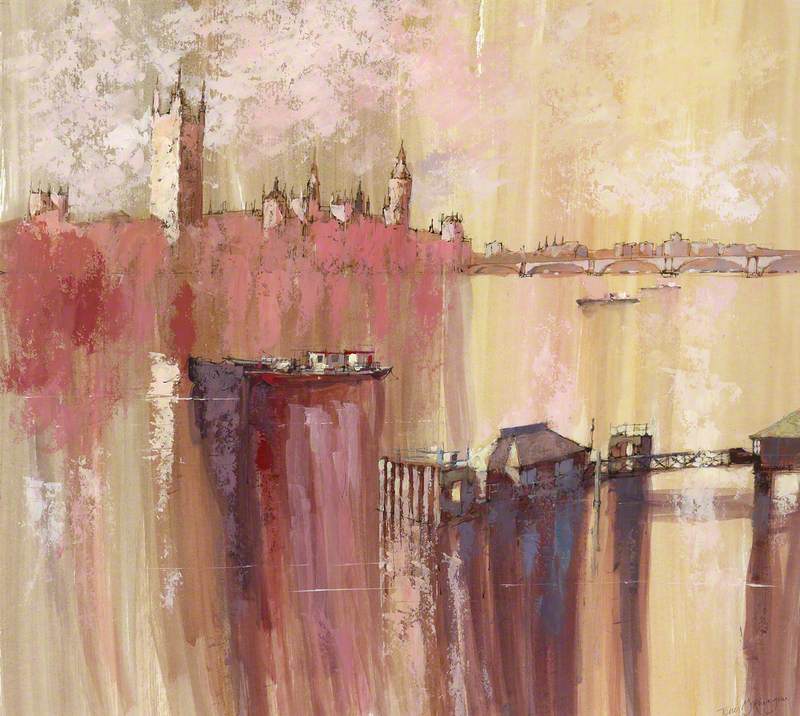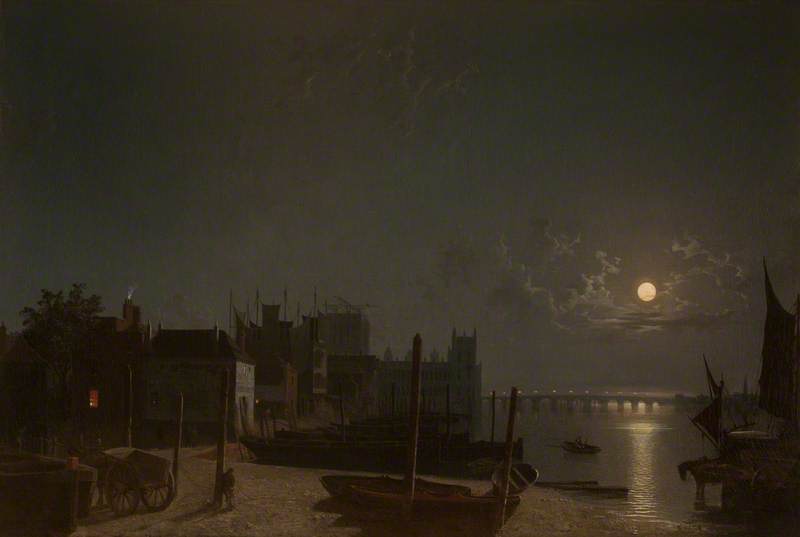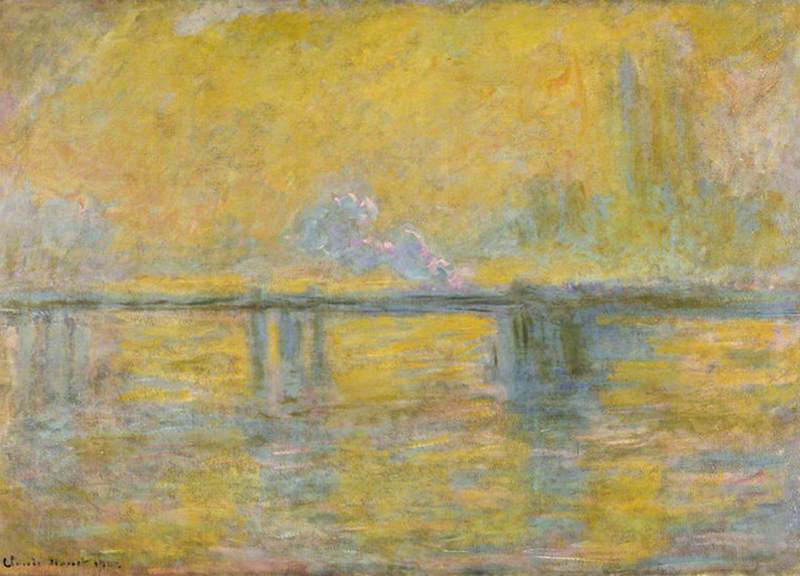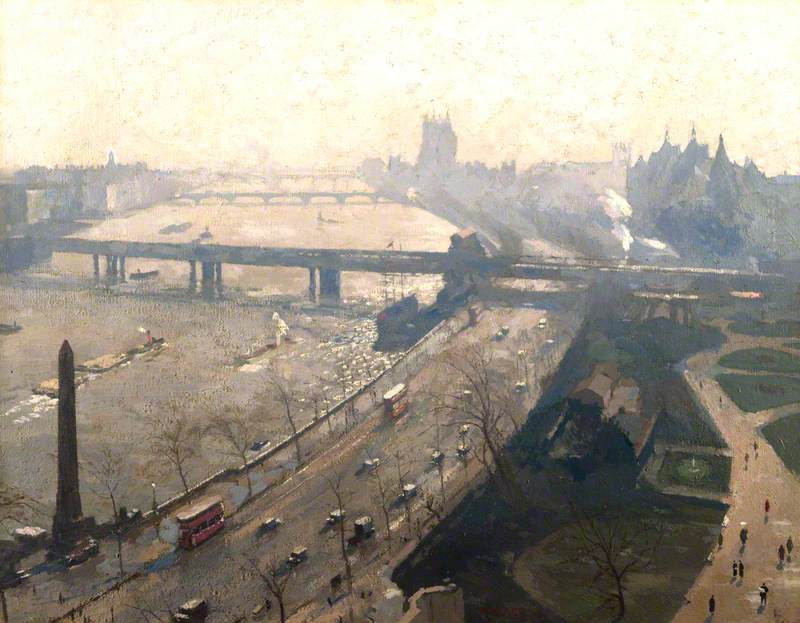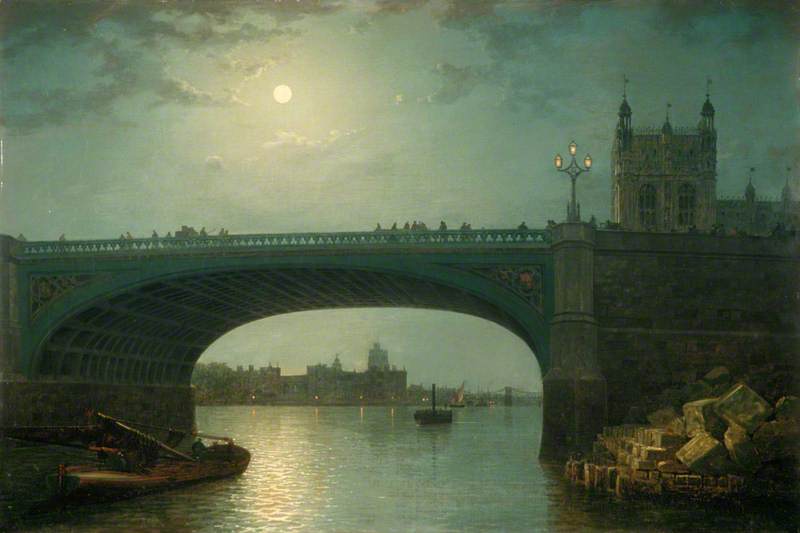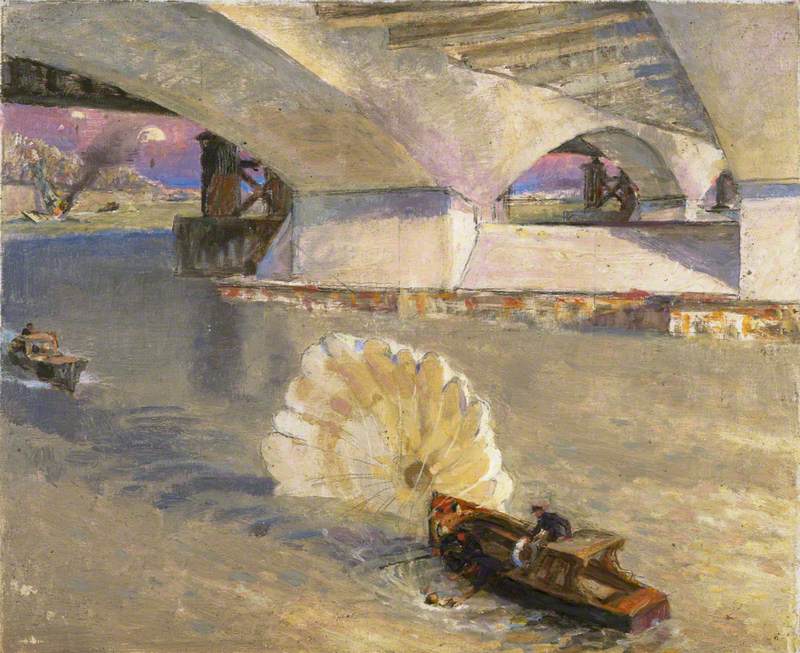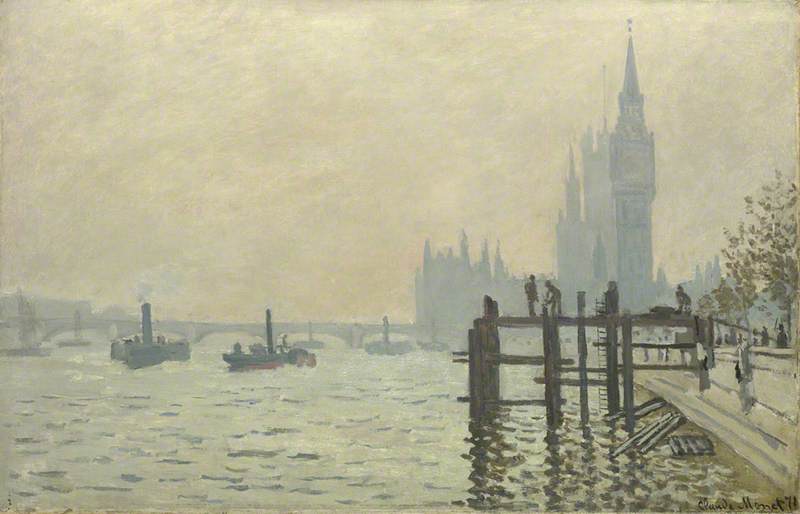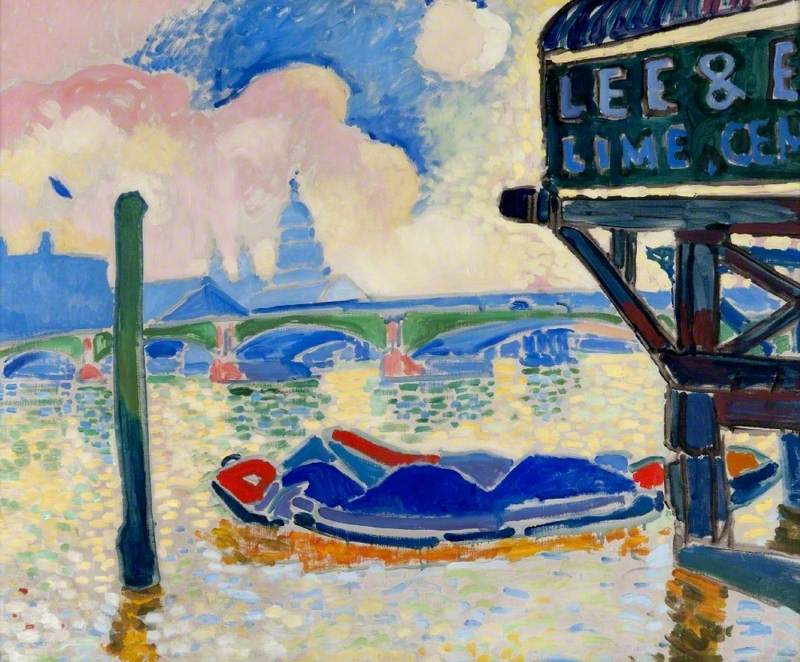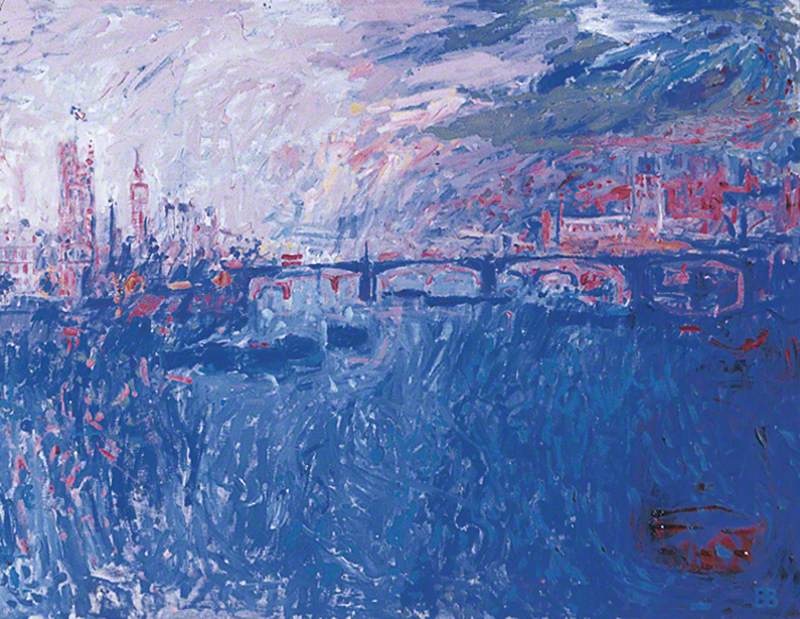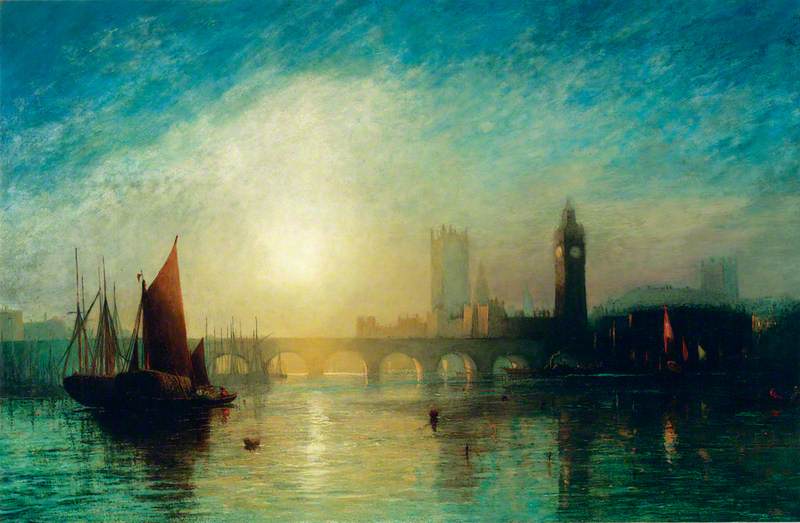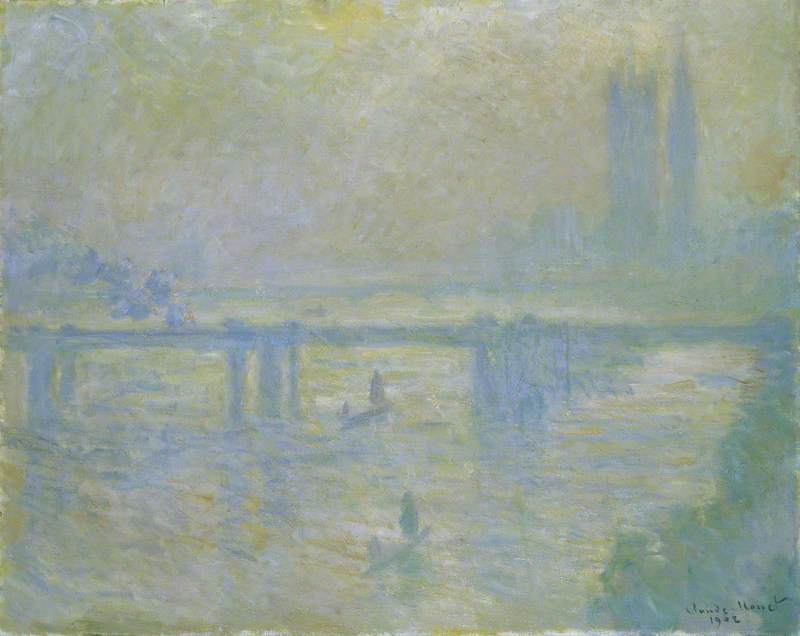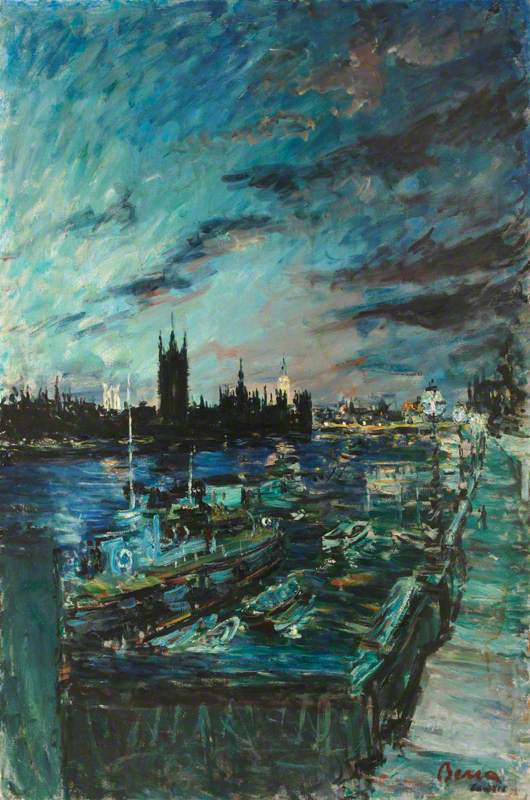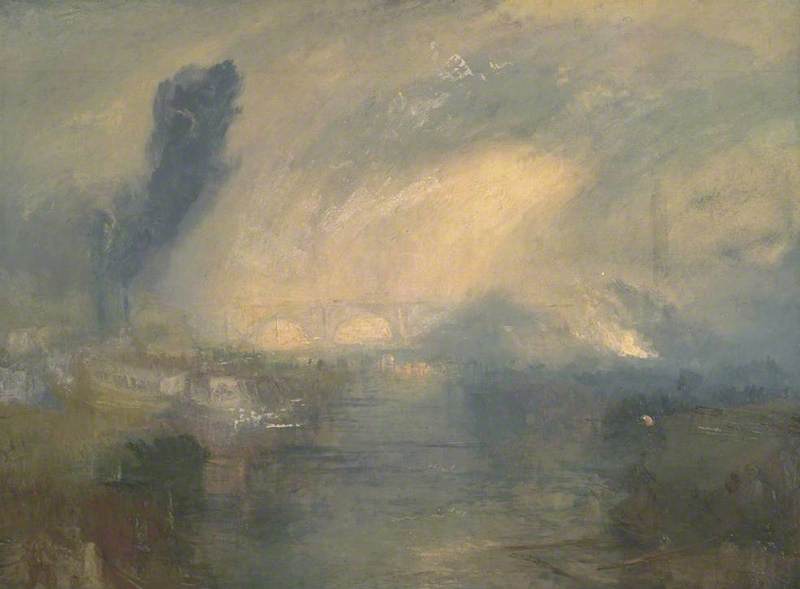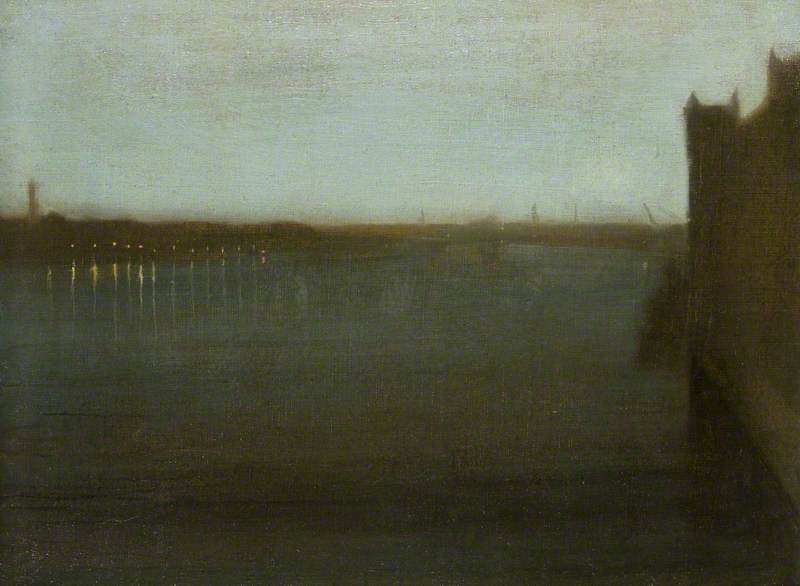Illuminated River is a major mayoral public art project to light up the central London bridges along the Thames. Next year, five more bridges will be lit, making it the longest public artwork in the world. Illuminated River artist Leo Villareal joins a long tradition of artists who have been inspired by the Thames and its bridges. Villareal’s light compositions mimic the ever-changing movement of the river, using shifting hues drawn from the London sky during sunset, through nightfall and under moonlight. In this exhibition, Villareal selects paintings of the next bridges to be illuminated, from artists whose approach to light and colour has resonance with his own.
To find out more, visit https://illuminatedriver.london
-
Evening Sun, Westminster
“McKivragan’s work merges realistic depictions of Westminster and its surroundings with large and bold patches of purple, pink, and mauve that are loosely applied, blending the sides of the buildings with the water of the Thames. It is interesting how the painting melts and almost falls off the bottom of the canvas in a waterfall of colour”
Terry McKivragan (1929–2013)
Acrylic on canvas
H 65.6 x W 73.3 cm
Parliamentary Art Collection
-
Westminster from the Horse-Ferry Quay by Moonlight 1852
“The Thames and Westminster are enveloped in the quiet of night with a single lonely figure leaning against a post in Henry Pether’s painting. The moon shines above, beautifully illuminating the water and clouds. Lanterns dot the top of the bridge, punctuating this vital connecting link. On the left side of the canvas, one can see signs of life as a single orange candle glows in a window and a puff of smoke catches the white moonlight as it floats up into the sky. It is inspiring to see how important darkness is in creating powerful moments of contrast where light appears”
Henry Pether (1800–1880)
Oil on canvas
H 59.5 x W 90 cm
National Trust, Dorneywood
-
London, Waterloo Bridge 1926
“Kokoschka’s expressionistic work vibrates with life and energy. It seems as if there are several micro compositions within the painting. St Paul’s looks surprisingly clearly rendered considering the economy of strokes. The sky and water are punctuated with strong linear marks that reveal directly the hand of the artist and perhaps indicate the direction of the tide or rising clouds. Waterloo Bridge undulates across the canvas, a riot of dots atop the repeating arches below. Boats look as if they have melted into pools of colour, simultaneously legible and abstract. It is thrilling to feel as if one is seeing this scene through the artist's eyes and I am eager to make my own interpretation of Waterloo Bridge soon for Illuminated River”
Oskar Kokoschka (1886–1980)
Oil on canvas
H 89.2 x W 129.6 cm
Amgueddfa Cymru – National Museum Wales
-
Pont de Londres (Charing Cross Bridge, London) 1902
“This Monet verges on almost complete abstraction. We are anchored by the bridge that cuts horizontally across the canvas in dark green and bluish tones. A puff of smoke blends into the sky, atmosphere meeting atmosphere. The golden yellow haze brings to mind dawn in springtime. Horizontal marks define the churning water of the Thames. Above the bridge, everything is pulled upwards as if by a magnetic force. I am drawn to the connection between an expansive sky and its reflection in the water below”
Claude Monet (1840–1926)
Oil on canvas
H 64 x W 90 cm
National Trust, Chartwell
-
The Embankment, Westminster 1934
“The luminous sky is so bright that it begins to blow out the top of the painting which gradually takes on more specificity as it gets closer to the bottom. I think of photography and the way certain parts of the picture plane can be in focus while others are not. The bridges are a series of stunning teal, lavender and light peach as they gain warmth in the distance. The white highlights on the surface of the water add opticality and realism to the depiction. The trees, bare of leaves, suggest a wintery scene in the busy city, the same conditions I will experience when I get the chance to program the next five bridges for Illuminated River”
Donald Chisholm Towner (1903–1985)
Oil on canvas
H 58.5 x W 75 cm
Royal Academy of Arts
-
Parliament and Lambeth Palace, London 1978
“We are up high at an interesting eye level that the artist could not have physically experienced in this stylized painting. The precise geometric strokes that mark Lambeth Bridge in red correspond nicely to the iconic double-decker buses. All of this occurs within a generally muted and pastel environment. Westminster and its surroundings are painstakingly rendered. I am most interested in the water and the way the currents are depicted by arching forms. The reflection of the bridge is fascinating in its brown toned and almost pointillist strokes”
Alfred Daniels (1924–2015)
Oil on canvas
H 70 x W 100 cm
City of London Corporation
-
Westminster Bridge by Moonlight c.1862
“The green hue of Westminster Bridge, inspired by the green seats of the nearby House of Commons, is beautifully captured by Pether in all its glory. Touches of golden moonlight activate the surface of the water and also dot the landscape. The massive scale of the bridge is reinforced by the small figures that look down from above onto the gorgeous nocturnal scene as a boat, mast down, moves along the Thames. The luminous clouds hover above, catching the magical light of the moon. This painting reveals the Gothic beauty of Barry’s design, which I am honoured to bring to life in a manner that respects the history and architecture of this bridge on the edge of a UNESCO World Heritage site”
Henry Pether (1800–1880)
Oil on canvas
H 60 x W 90 cm
Government Art Collection
-
Wartime Traffic on the River Thames: River Police at Waterloo Bridge during the Battle of Britain 1942
“I am drawn to the pinkish blue sky in the distance and to the robustly rendered underside of Waterloo Bridge. The dappled edges of the pier are interesting in their use of colour, with unexpected dots of ochre and red. The wooden piers next to the bridge reveal it is still under construction, and the tectonic spine of the new structure, which I will be illuminating, is also visible. The parachute is beautifully depicted as it catches wind and light. One can make out a Luftwaffe cross, identifying the fallen plane in the top left as German. The water ripples in cool blue connect the boats and one cannot help but feel deep empathy for the pilot being rescued”
John Edgar Platt (1886–1967)
Oil on panel
H 19 x W 22.8 cm
IWM (Imperial War Museums)
-
Westminster from near the Terrace of Somerset House c.1750
“Canaletto's use of colour is incredibly subtle and finely rendered. Here a warm haze rises from the left side of the canvas, creating a beautiful transition from light peach to sky blue. This abstract gradation inspires me when thinking about my artwork for Illuminated River. It is intriguing how there is hardly any difference between sky and water besides a variation in darker grey towards the foreground. It is almost as if one were looking at a photograph in this detailed depiction of 18th Century life on the Thames”
Canaletto (1697–1768)
Oil on canvas
H 38.7 x W 71.8 cm
Yale Center for British Art
-
Great Thames IV 1988–1989
“This painting remains firmly abstract and does not offer clues, besides its title, as to what we are looking at. Greens and blues evoke river water and the many marks look as if raindrops have fallen onto the surface of the canvas. The touches of acid green offer nice punctuation marks, as do the brown and beige textured elements. I am intrigued by the yellow mark on the left side of the painting and continue peering into the work in search of meaning”
Frank Bowling (b.1934)
Acrylic on canvas
H 181 x W 321 cm
Arts Council Collection, Southbank Centre
-
The Thames below Westminster about 1871
“This Monet is pale and luminous with strong contrast between a maximally illuminated sky behind a shadowed Parliament. Things get darker (and sharper) as they get closer with the structure of the pier delineated in a series of vertical and horizontal strokes, then abstracted in their reflections. The water is depicted masterfully with sparse green strokes. The smoke from a boat merges with the blurry sky, a slightly bluer tone. The horizontality of the bridge demarcates the transition between water and sky. This painting brings to mind the many different perspectives from which London’s bridges are visible and reminds me how important it is to look from as many points of view as possible when considering my work for Illuminated River"
Claude Monet (1840–1926)
Oil on canvas
H 47 x W 73 cm
The National Gallery, London
-
Blackfriars Bridge, London 1906
“Derain brings his very specific Fauvist style to this painting with bright and primary colours. The sides of Blackfriars Bridge are green with blue undersides and the pillars are a salmon colour. The green evokes a surface in shadow and the blue reflection of the water bounces off the undersides of the arches. The dashed surface of the water reminds me of pixels. The work feels optimistic and filled with life. St Pauls hovers in the distance, slightly askew, blurred out as it merges with the lavender clouds”
André Derain (1880–1954)
Oil on canvas
H 80.7 x W 99.5 cm
Glasgow Life Museums
-
Blackfriars Bridge II 2010
“I love this Luszczak painting's almost psychedelic effect. The brushwork on the swirling water is striking in its raw strokes of light blue that evoke the churning water of the Thames. The diagonal lines reflected in the water pull the warm red of electric light into the cooler areas. The vertical slots one sees through the piers are like another micro composition. There is a wildness in the whirls of water below balanced with the explosive quality of electric light and kinetic activity of machines above”
Stefan Luszczak (b.1960)
Oil on canvas
H 80 x W 100 cm
Clare Hall, University of Cambridge
-
The Houses of Parliament from the River 1864
“The intensity of colour in Danby’s painting is quite striking with its orange red core that radiates outwards from the centre. The cinematic quality of this canvas is almost apocalyptic, as the setting sun expels energy, vaporizing everything around it. The buildings melt into the mist and the foregrounded boats pull us back to reality. I feel like I am seeing a very specific and special moment through another artist’s eyes”
James Francis Danby (1816–1875)
Oil on canvas
H 44.4 x W 74.9 cm
Paintings Collection
-
Lambeth Bridge, London 1959
“The celebratory riot of lines and dots that Bobak uses in rendering his painting seem to be constantly pushed and pulled by invisible forces. The river swirls as confetti flies above. Flags wave in the magnetic sky as strokes transition from their primary red and blue into an ephemeral lavender sky. I am inspired by the ability to create order out of chaos and to be able to express a very powerful emotion through relatively minimal and simple gestures”
Bruno Bobak (1923–2012)
Oil on canvas
H 76.2 x W 101.6 cm
Leeds Museums and Galleries
-
View of Westminster Bridge and the Houses of Parliament with a Hay Barge 1859
“What inspires me most about Danby’s painting is his striking use of line- in some places it is sharp and clear and in others it blurs and softens into the background. I like the optical intensity of this work and think of a cinematic focus pull effect in which a certain area of the canvas is emphasized. The palette is pastel and diffused in the centre but becomes more saturated as it moves towards the edges of the canvas. I am also intrigued by the contrast of extremely dark areas with extremely bright areas in a single composition”
James Francis Danby (1816–1875)
Oil on canvas
H 81 x W 123 cm
Parliamentary Art Collection
-
Charing Cross Bridge 1902
“Although Monet painted the same scene many times, each approach brings a unique ‘impression’. Charring Cross Bridge, the old Hungerford Bridge, is revisited repeatedly. Here the palette is cool and crisp and yet diffused, limited to greens, blues and hints of yellow. White highlights punctuate the scene, creating a compelling contrast and picking out the boats on the river and also the shimmering surface of the water. The architectural mass of the bridges and Parliament blur into the sky, smoke, water and fog”
Claude Monet (1840–1926)
Oil on canvas
H 65.4 x W 81.3 cm
Amgueddfa Cymru – National Museum Wales
-
Dusk on the Thames at Westminster 1953/1954
“My eye is drawn to the way the brush strokes in the sky radiate vertically outwards, spreading from the left side of the painting to a ninety degree angle on the right. The combination of luminous moments contrasted with the dark and shadowy Westminster gives a lot of depth. The architecture in the background is much sharper than the boats and docks in the foreground, which one would think would be more defined as they are closer to the viewer”
Dimitrie Berea (1908–1975)
Oil on panel
H 154 x W 128 cm
National Trust, Chartwell
-
The Thames above Waterloo Bridge c.1830–5
“Turner’s pastel tones in blue, green, and warm pink create a composition that challenges a viewer's compulsion to recognize and make meaning. There are certain clues like the bridge, some architectural forms to the sides of the painting, and a boat, or perhaps several boats. Besides that, we are immersed in a disorienting tempest of blended atmosphere where water and sky become one. I am interested in how light on bridges can help to demarcate their architectural structures and simultaneously serve as ‘active camouflage’, concealing them before our very eyes as they blend into their surroundings”
Joseph Mallord William Turner (1775–1851)
Oil on canvas
H 90.5 x W 121 cm
Tate
-
Nocturne: Grey and Gold, Westminster Bridge c.1871–1872
“Whistler’s Nocturne at first appears drained of all saturation but as one looks more deeply, tones of grey and gold become apparent. Subtle gradations of green and brown horizontal strokes evoke water underneath the muted sky. Tiny golden lights and their blurred reflections punctuate the edge of the river. There is life and energy here. One just has to look. Like many of the artists featured, Whistler worked ‘en plein air’ sketching the bridges from the riverbanks or from a boat afloat on the water, taking in the surrounding atmosphere with all of his senses, the same process I will be using to create artwork for Illuminated River”
James Abbott McNeill Whistler (1834–1903)
Oil on canvas
H 71 x W 86.4 cm
Glasgow Life Museums
Explore artists in this Curation
View all 16-
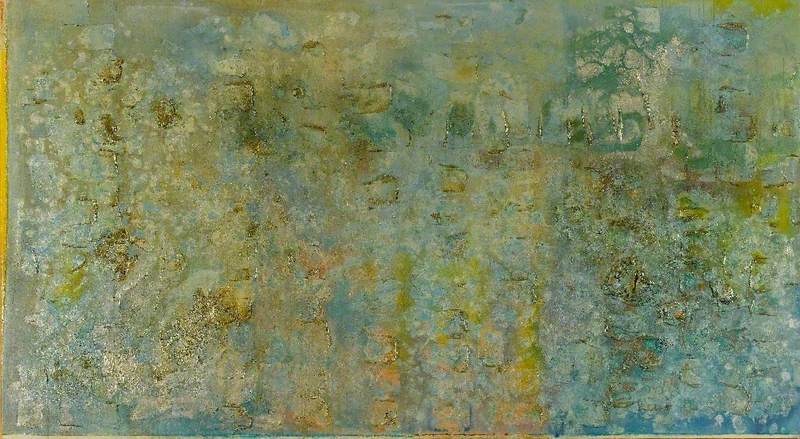 Frank Bowling (b.1934)
Frank Bowling (b.1934) -
 Terry McKivragan (1929–2013)
Terry McKivragan (1929–2013) -
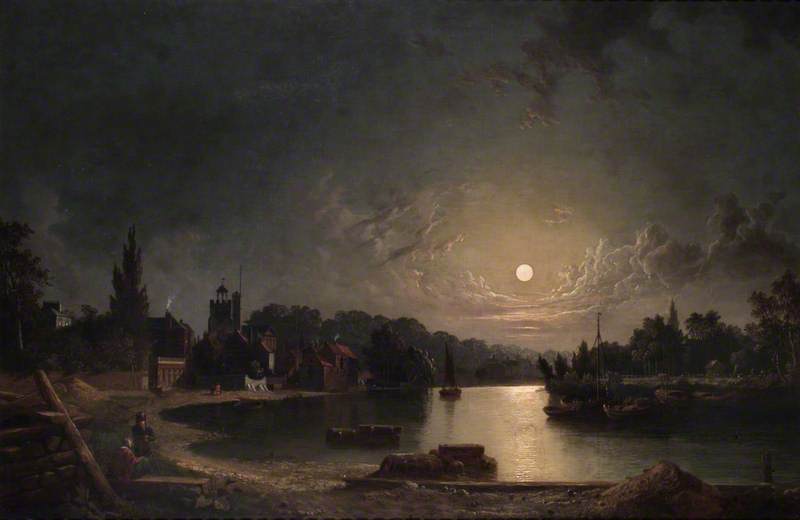 Henry Pether (1800–1880)
Henry Pether (1800–1880) -
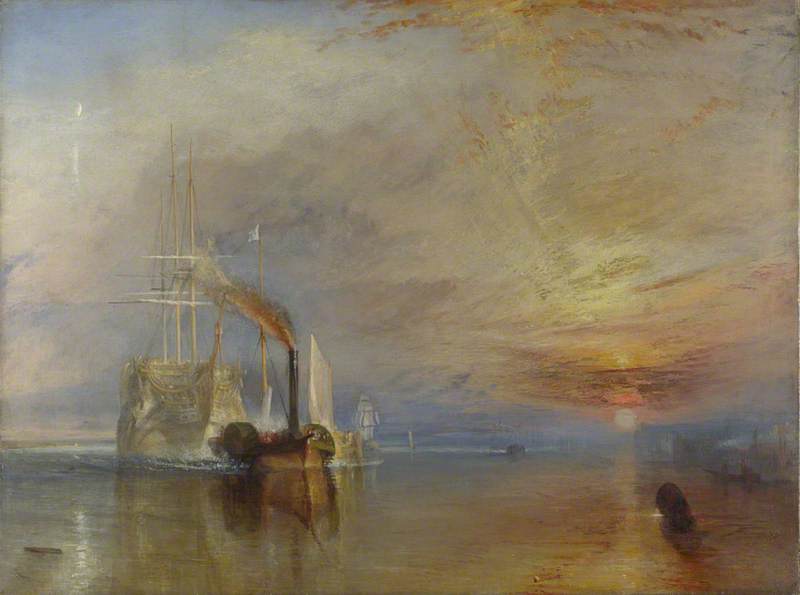 Joseph Mallord William Turner (1775–1851)
Joseph Mallord William Turner (1775–1851) -
 Stefan Luszczak (b.1960)
Stefan Luszczak (b.1960) -
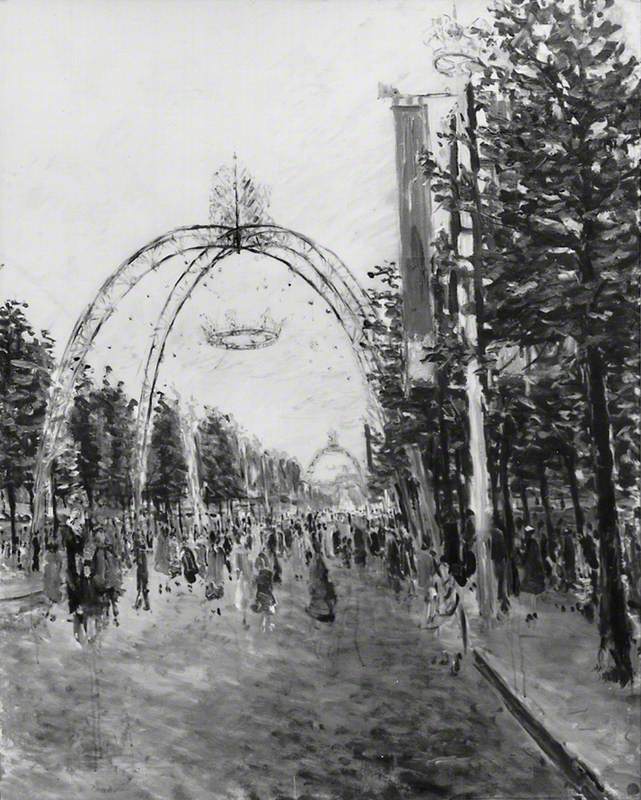 Dimitrie Berea (1908–1975)
Dimitrie Berea (1908–1975) -
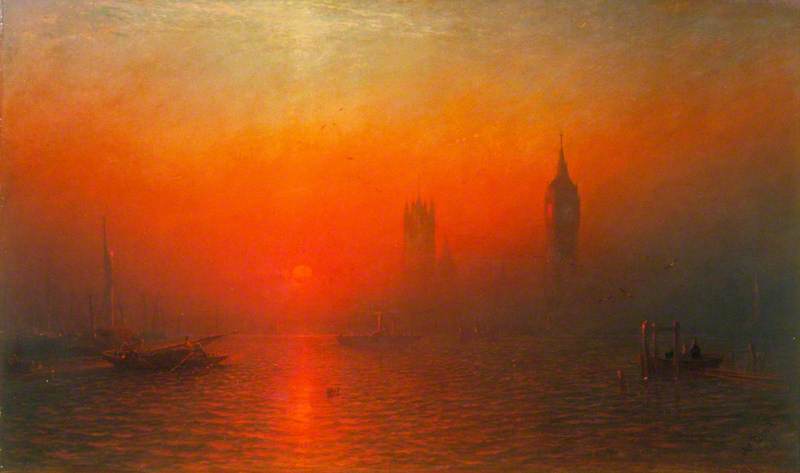 James Francis Danby (1816–1875)
James Francis Danby (1816–1875) -
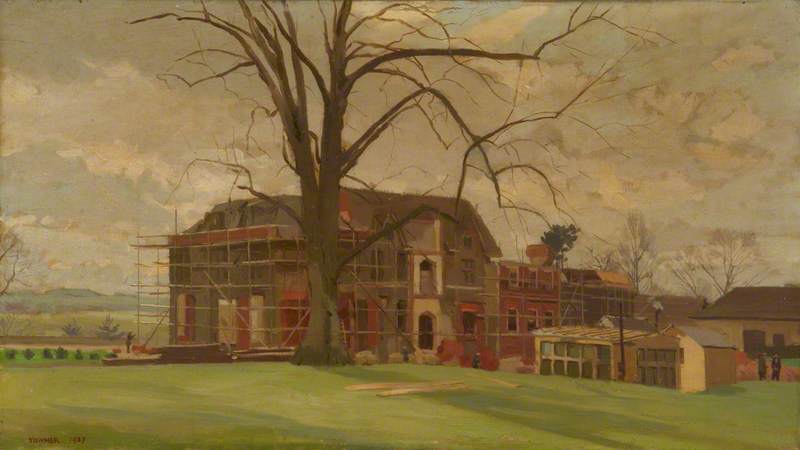 Donald Chisholm Towner (1903–1985)
Donald Chisholm Towner (1903–1985) -
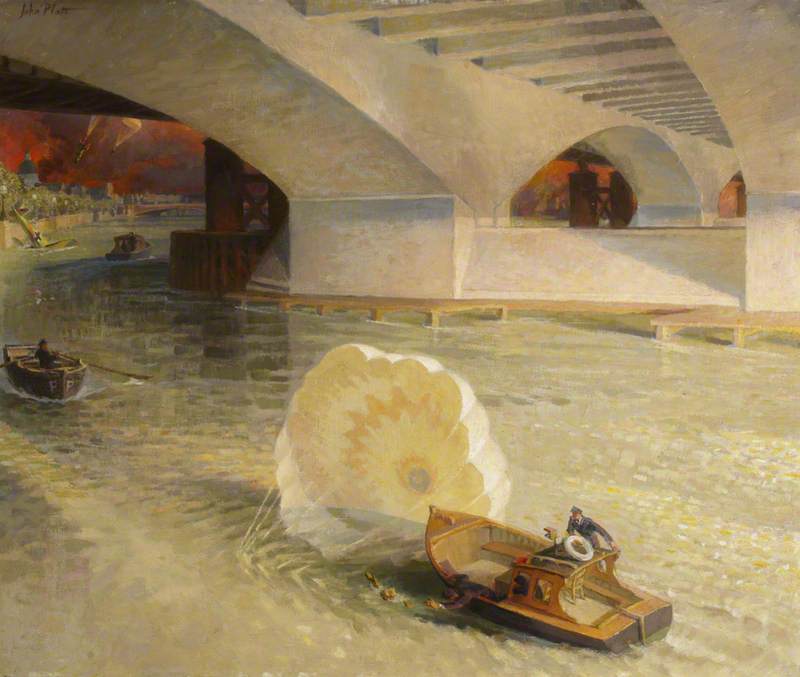 John Edgar Platt (1886–1967)
John Edgar Platt (1886–1967) -
 Bruno Bobak (1923–2012)
Bruno Bobak (1923–2012) - View all 16
